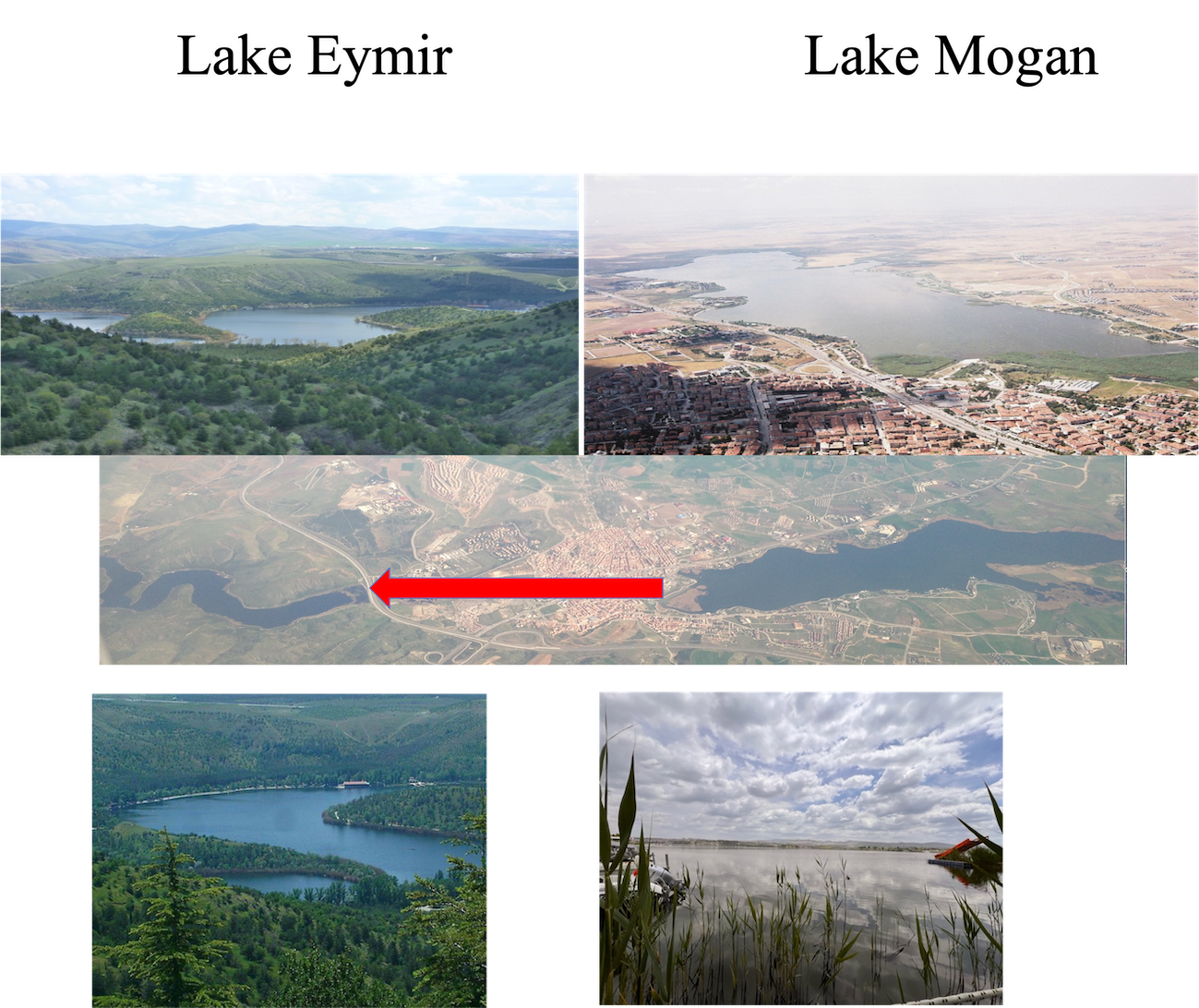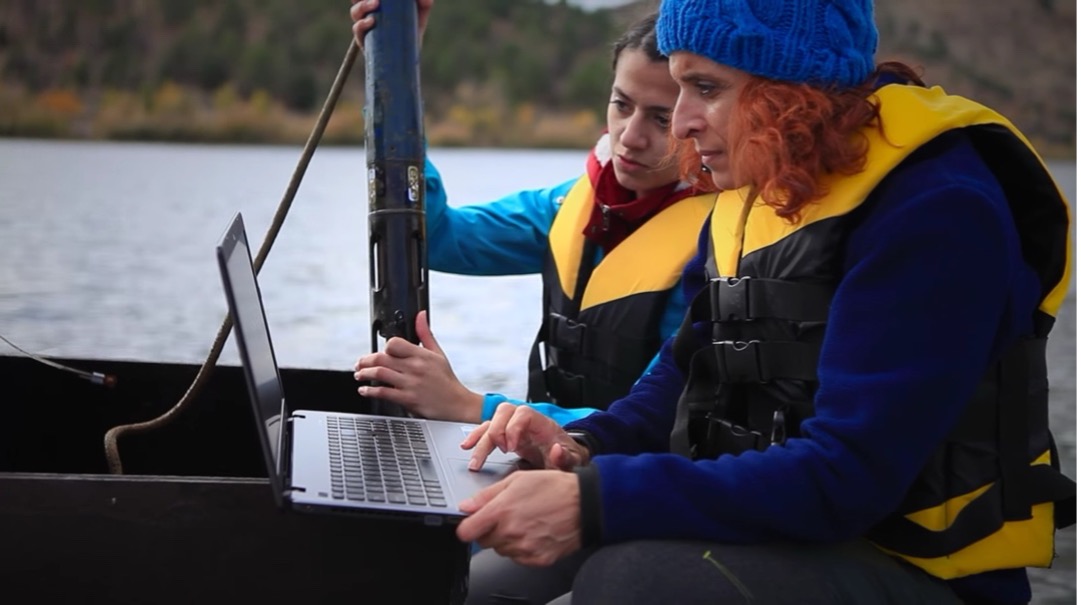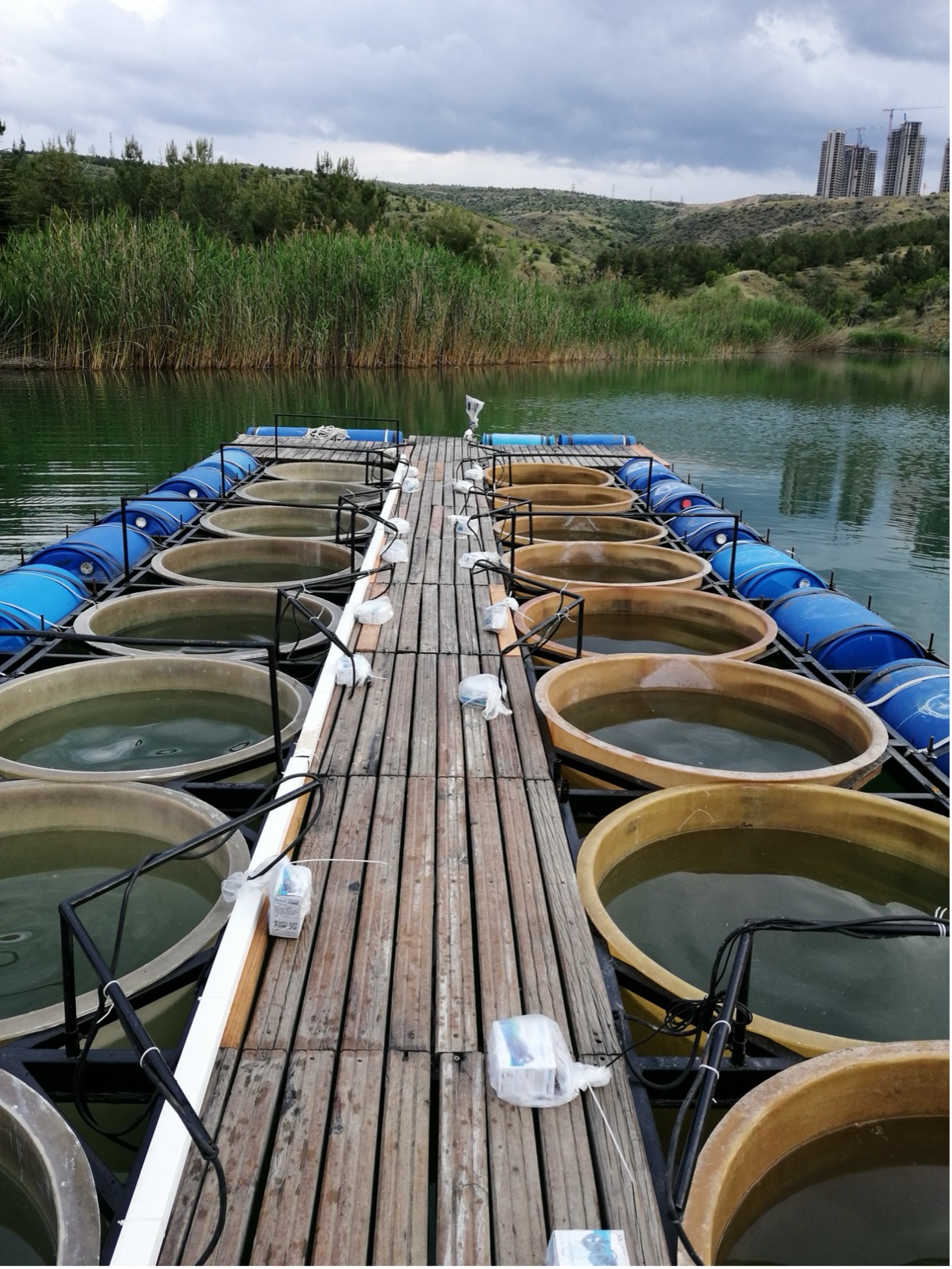LAKE MOGAN & LAKE EYMİR- TÜRKİYE
Basic Information
DEIMS.iD: https://deims.org/6bf2bf7a-f392-4a19-95b1-783286489d6c
Site Name: Mogan & Eymir
Short name: EM
Country: Türkiye
Site Manager: Prof. Dr. Meryem Beklioğlu
Site Description
Lakes Mogan and Eymir (EM) are two connected alkaline lakes located about 20 km south of Ankara, Türkiye. Lake Mogan covers 5.6–5.8 km², with an average depth of 2.4 m and a maximum depth between 2.8 and 5.3 m. In contrast, Lake Eymir spans 1–1.3 km², has a mean depth of 3.2 m, and has a maximum depth of 3.4 to 6.5 m. Together, the lakes cover 1010 km², with 68% used for agriculture, mainly wheat. Despite serving urban housing and recreation, they have high wildlife and biodiversity values. Both lakes have the status of Special Protection Areas, furthermore, Lake Mogan is additonally an Important Bird Area.
Because of the high elevations of the Anatolian plateau (>1000 m), EM are exposed to a Central Anatolian arid-cold steppe climate. The EM experiences significant seasonal water level fluctuations because of their high plateau setting, with hot summers and cold winters. The average annual temperature is 12°C, with a range of -8°C to 36°C. Total precipitation in the catchment is 408 mm, with evaporation higher than precipitation in summers. This hydrology is associated with periodic droughts, leading to large water level fluctuations.
Lake Mogan is fed by groundwater and surface flows, with four major inflows and several ephemeral streams. The main inflows, Sukesen, Gölcük, Yavrucak, and the Çölovası wetland area, account for 90% of the total hydraulic loading. The Lake Mogan's outflow, which flows through a wetland, feeds Lake Eymir, which is regulated to control flooding in low-lying areas of Ankara. Besides the main southern inflow from Lake Mogan, a minor second inflow (Kışlakçı) near the Lake Eymir's north end contributes to its flow during spring snowmelt.
The Lakes Mogan and Eymir Ecological Monitoring and Restoration Programme (EMEM-RP) in Türkiye has been continously carried out for 27 years by Centre for Ecosystem REsearch (EKOSAM). EMEM-RP is the only uninterrupted continuous freshwater research programme in the country. The program involves sampling the lakes every two weeks, analyzing various parameters including depth, Secchi depth, oxygen, pH, conductivity, suspended solids, silicate, alkalinity, chlorophyll-a, total phosphorus, soluble reactive phosphorus, total nitrogen, and dissolved inorganic carbon (NH₄ + NO₂,₃). Additionally, zooplankton, phytoplankton, and ciliate samples are collected. Fish and macrophyte samplings from both lakes are gathered yearly through field surveys.
Lake Mogan was once a clear-water lake with abundant macrophytes, including Chara spp. and pondweed, and low chlorophyll-a (8.8 μg/L) and total phosphorus (63 μg/L) concentrations. However, sediment dredging activity by the government has reduced diversity, resulting in a eutrophic state with high nutrients (Total Phosphorus: 91.3 μg/L, Total Nitrogen: 1980 µg/L) concentrations due to internal loading.
Lake Eymir' water was clean enough to meet the drinking water needs of Middle East Technical University before the 1970s. However, between 1970 and 1995, its water quality deteriorated due to the influx of untreated sewage effluent. In 1995, an effective sewage effluent diversion resulted in an 88% reduction in phosphorus input. EMEM-RP characterized Lake Eymir as an eutrophic lake, with high total phosphorus levels of approximately 222 µg/L, total nitrogen concentrations around 1755 µg/L, and chlorophyll-a levels averaging 22.4 µg/L. In Lake Eymir, was biomanipulated twice in 1998-1999 and 2006-2014 with the aim to remove benthi-planktivorous fish and prohibit pike fishing. After removing 50% of the common carp and tench stock from Lake Eymir, chl-a and suspended solid concentrations dropped, and Secchi depth increased 2.5-fold. This led to macrophyte coverage expanding from 2.5% to 40-90% post-biomanipulation. However, the lake shifted back to a turbid water state, with low macrophyte coverage and recovering carp and tench populations during the drought period from 2003 to 2009.
Lately EMEM-RP has included continous monitoring using a standardized platform with a sonda and the data have been continously streamed using LoRA. Furthermore, associated with EMEM-RP, there are two mesocosms facilities that belong to EKOSAM that METU Mesocosm System I is in-situ with low and high water level of 16 mesocosms for carring out experiments especially related to water level changes. The recent mesocosms facility named METU Mesocosms System II (MMS II) includes 24 mesocosm reflecting shallow water lakes and ponds including sediment, macrophytes fish and the rest of the food web. In MMS II, freshwater salinization experiments are being carried out to understand the impact of salnization on ecosystem structure, function and biodiversity.

The Lake Mogan and Lake Eymir Ecological Monitoring Research Programme

METU Mesocosms System I (MMS I)

METU Mesocosms System II (MMS II)

Geographic Information:
Centroid/Representative Coordinates: Latitude: 39.773182 Longitude: 32.791958
Size: ca. 2824.37ha
Elevation (average): 970.00msl
Elevation (min): 870.00msl
Elevation (max): 1265.00msl
Download for site location
• Site information [.json]
• Centroid/representative coordinates [.shp] [.kml]
• Bounding Box [.shp] [.kml]
• Boundaries [.shp] [.kml]
Observed properties
1. Physical parameters :
• Conductivity
• Oxygen saturation
• Oxygen concentration
• Temperature
• Water depth
• Water transparency
• Suspended solid
2. Chemical parameters:
• Total nitrogen
• Dissolved inorganic nitrogen
• Total phosphorus
• Soluble reactive phosphorus
• Alkalinity
• Silicate
• Salinity
• Chlorophyll-a
3. Biological parameters:
• Zooplankton
• Phytoplankton
• Macrophyte PVI
• Fish
Site Details
GEO-BON Biome: Freshwater lakes
Ecosystem Type
Forest
Lakes
Fresh Water Lakes
Small lakes
Urban
Biogeographical Region: Anatolian Bio-geographical Region
EUNIS habitat
Constructed, industrial and other artificial habitats (J)
Constructed, industrial and other artificial habitats (J) » Buildings of cities, towns and villages (J1)
Habitat complexes (X)
Inland surface waters (C)
Regularly or recently cultivated agricultural, horticultural and domestic habitats (I)
Woodland, forest and other wooded land (G)
Air Temperature: Average Annual: 12.00°C
Precipitation Annual: 408.00mm
Geology: Quaternary land, Conglomerate layers, Limestone, Permien Graywacke, Permo-carboniferous, Epi-metamorphic
Vegetation: Steppe vegetation, Forest vegetation, more than 700 plant species exist in the area, 50 of them are endemic.
Soils: Alluvial soil, Hydromorphic soil, Saline-alkaline soil, Colluvial soil, Brown soil
Hydrology: Lake Mogan, which is located above, is fed both from groundwater and surface water, and it has 4 main streams flowing throughout the year, 3 of which are inflows and 1 is outflow, and many lots of short-lived streams. The outflow of the lake has been controlled since 1974 due to flooding. This current of Lake Mogan is the largest inflow source of Lake Eymir. In addition to the Mogan inflow, Lake Eymir also has another inflow, which is fed by groundwater and surface water and it is observed only in spring season. The only outflow of Lake Eymir is also controlled like in Lake Mogan.
On going monitoring
Accessible All Year: Yes
All parts of Site Accessible: Yes
Permanent Operation: Yes
Site Visit Interval: 15
Maintenance Interval: 15
List of Publications
2023 Fish Size Structure as an Indicator of Fish Diversity: A Study of 40 Lakes in Turkiye, https://doi.org/10.3390/w15122147
2021 Determinants of phytoplankton size structure in warm, shallow lakes, https://doi.org/10.1093/plankt/fbab035
2020 The impact of climate change on a Mediterranean shallow lake: insights based on catchment and lake modelling, https://doi.org/10.1007/s10113-020-01641-6
2020 Influences of climate and nutrient enrichment on the multiple trophic levels of Turkish shallow lakes, https://doi.org/10.1080/20442041.2020.1746599
2020 Impacts of multiple stressors on freshwater biota across spatial scales and ecosystems, https://doi.org/10.1038/s41559-020-1216-4
2018 Patterns of microbial food webs in Mediterranean shallow lakes with contrasting nutrient levels and predation pressures, https://doi.org/10.1007/s10750-017-3329-6
2018 Non-native Fish Occurrence and Biomass in 1943 Western Palearctic Lakes and Reservoirs and their Abiotic and Biotic Correlates, https://doi.org/10.1007/s10021-017-0156-6
2018 Size diversity and species diversity relationships in fish assemblages of Western Palearctic lakes, https://doi.org/10.1111/ecog.03255
2018 Non-native Fish Occurrence and Biomass in 1943 Western Palearctic Lakes and Reservoirs and their Abiotic and Biotic Correlates, https://doi.org/10.1007/s10021-017-0156-6
2018 Temperature Effects Explain Continental Scale Distribution of Cyanobacterial Toxins, https://doi.org/10.3390/toxins10040156
2017 Restoration of Eutrophic Lakes with Fluctuating Water Levels: A 20-Year Monitoring Study of Two Inter-Connected Lakes, https://doi.org/10.3390/w9020127
2017 Size-based interactions across trophic levels in food webs of shallow Mediterranean lakes, https://doi.org/10.1111/fwb.12997
2016 Impact of alternating wet and dry periods on long-term seasonal phosphorus and nitrogen budgets of two shallow Mediterranean lakes, https://doi.org/10.1016/j.scitotenv.2016.04.028
2016 Inferring past environmental changes in three Turkish lakes from sub-fossil Cladocera, https://doi.org/10.1007/s10750-015-2581-x
2016 Fish assemblage and diversity in lakes of western and central Turkey: role of geo-climatic and other environmental variables, https://doi.org/10.1007/s10750-015-2608-3
2015 Size-based diel migration of zooplankton in Mediterranean shallow lakes assessed from in situ experiments with artificial plants, https://doi.org/10.1007/s10750-015-2192-6
2015 Factors influencing nitrogen processing in lakes: an experimental approach, https://doi.org/10.1111/fwb.12511
2015 Ecological impacts of global warming and water abstraction on lakes and reservoirs due to changes in water level and related changes in salinity, https://doi.org/10.1007/s10750-014-2169-x
2015 Factors influencing nitrogen processing in lakes: an experimental approach, https://doi.org/10.1111/fwb.12511
2015 Temperature effects on body size of freshwater crustacean zooplankton from Greenland to the tropics https://doi.org/10.1007/s10750-014-2000-8
2014 Water level and fish-mediated cascading effects on the microbial community in eutrophic warm shallow lakes: a mesocosm experiment https://doi.org/10.1007/s10750-014-1934-1
2014 Relatedness between contemporary and subfossil cladoceran assemblages in Turkish lakes https://doi.org/10.1007/s10933-014-9799-x
2014 Similarity between contemporary vegetation and plant remains in the surface sediment in Mediterranean lakes https://doi.org/10.1111/fwb.12299
2014 Generation of the bathymetry of a eutrophic shallow lake using WorldView-2 imagery https://doi.org/10.2166/hydro.2013.133
2013 Levels, distribution, and sources of polychlorinated biphenyls in sediments of Lake Eymir, Turkey https://doi.org/10.1007/s00244-013-9900-x
2013 Apportionment of PCB sources near a transformer maintenance and repair facility in Ankara, Turkey https://doi.org/10.1007/s00128-013-1019-2
2012 The influence of water level on macrophyte growth and trophic interactions in eutrophic Mediterranean shallow lakes: a mesocosm experiment with and without fish https://doi.org/10.1111/j.1365-2427.2012.02825.x
2011 Climate change effects on nitrogen loading from cultivated catchments in Europe: implications for nitrogen retention, ecological state of lakes and adaptation https://doi.org/10.1007/s10750-010-0547-6
2011 Water quality trend analysis in Eymir Lake, Ankara https://doi.org/10.1016/j.pce.2010.05.005
2010 Drought-induced changes in nutrient concentrations and retention in two shallow Mediterranean lakes subjected to different degrees of management https://doi.org/10.1007/s10750-010-0179-x
2009 Climate change effects on runoff, catchment phosphorus loading and lake ecological state, and potential adaptations https://doi.org/10.2134/jeq2008.0113
2009 Identification and mapping of submerged plants in a shallow lake using quickbird satellite data https://doi.org/10.1016/j.jenvman.2007.06.022
2008 Restoration of a shallow Mediterranean lake by biomanipulation complicated by drought https://doi.org/10.1127/1863-9135/2008/0171-0105
2007 Danish and other European experiences in managing shallow lakes https://doi.org/10.1080/07438140709354029
2007 State of the art in the functioning of shallow Mediterranean lakes: workshop conclusions https://doi.org/10.1007/s10750-007-0577-x
2006 Modeling complex nonlinear responses of shallow lakes to fish and hydrology using artificial neural networks https://doi.org/10.1016/j.ecolmodel.2006.02.003
2006 Water level control over submerged macrophyte development in five shallow lakes of Mediterranean Turkey https://doi.org/10.1127/0003-9136/2006/0166-0535
2005 Statistical Predictive Models in Ecology: Comparison of Performances and Assessment of Applicability https://doi.org/10.48550/arXiv.q-bio/0510031
2005 Absence of typical diel vertical migration in Daphnia: varying role of water clarity, food, and dissolved oxygen in Lake Eymir, Turkey https://doi.org/10.1007/s10750-004-2789-7
2005 Effects of waterfowl, large fish and periphyton on the spring growth of Potamogeton pectinatus L. in Lake Mogan, Turkey https://doi.org/10.1007/s10750-004-3077-2
2005 Catastrophic-like shifts in shallow Turkish lakes: a modeling approach https://doi.org/10.1016/j.ecolmodel.2004.07.033
2003 Hysteresis in vegetation shift—Lake Mogan prognoses https://doi.org/10.1016/S0304-3800(03)00050-4
2003 A structurally dynamic modelling—Lake Mogan, Turkey as a case study https://doi.org/10.1016/S0304-3800(03)00051-6
2003 Restoration of the eutrophic Lake Eymir, Turkey, by biomanipulation after a major external nutrient control I https://doi.org/10.1023/A:1023466629489
2002 Does Biomanipulation Work for Warm-Temperate Lakes? First Case Study in an Eutrophic Turkish Lake https://doi.org/10.1007/978-94-010-0491-6_16
